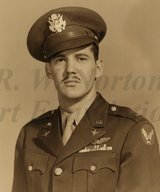
|

|
|
|
|
Born in Alexandria, Louisiana, Jerry enlisted in the Louisiana National Guard as a private at a dollar a day. He was in his fourth year in college when all guard units were mobilized into federal service on November 25, 1940. Jerry participated in the Louisiana Maneuvers in 1941, and then switched to the U.S. Army Air Forces. After navigation school, he was commissioned a second lieutenant on May 23, 1942 and ordered to Barksdale Field, where he flew as a navigator in B-24s. Many missions took them to the mouth of the Mississippi River where they patrolled for German submarines. Jerry was later placed in the 404th Bomb Squadron and sent to Ladd Field in Fairbanks, Alaska as part of the Eleventh Air Force, where he patrolled the Bering Sea for Japanese ships. Later he was stationed on Adak Island. He bombed Japanese ships in the harbor of Kiska, flying in at fifty feet, and dropping 2,000-pound explosives. Jerry earned a Purple Heart for wounds he suffered when an anti-aircraft round hit his B-24. Returned to the states in June of 1943, he was sent to Marfa, Texas where he flew "Bamboo Bombers," or AT-17s. After training there he was given his choice of duty stations and he chose to fly B-24s at White Sands, New Mexico. There he heard the boom of the first atomic bomb, but did not know it at the time. When the Air Force cancelled the B-24 program, Jerry volunteered for B-29 service in the Pacific. He trained in Puerto Rico, where "the officer's club had a beautiful marble veranda overlooking the Caribbean, and rum and Coke for a dime." Before going overseas, however, he was assigned to Biggs Army Airfield in El Paso, where a lieutenant colonel he had known in Alaska was director of flying training. He assigned Jerry to a B-17 to pick up B-29 crews whose aircrafts had malfunctioned in distant parts of the western United States. Jerry ended his service in February of 1946. He worked forty years for Nabors Trailers in Mansfield, ending his civilian career as plant engineer. |


